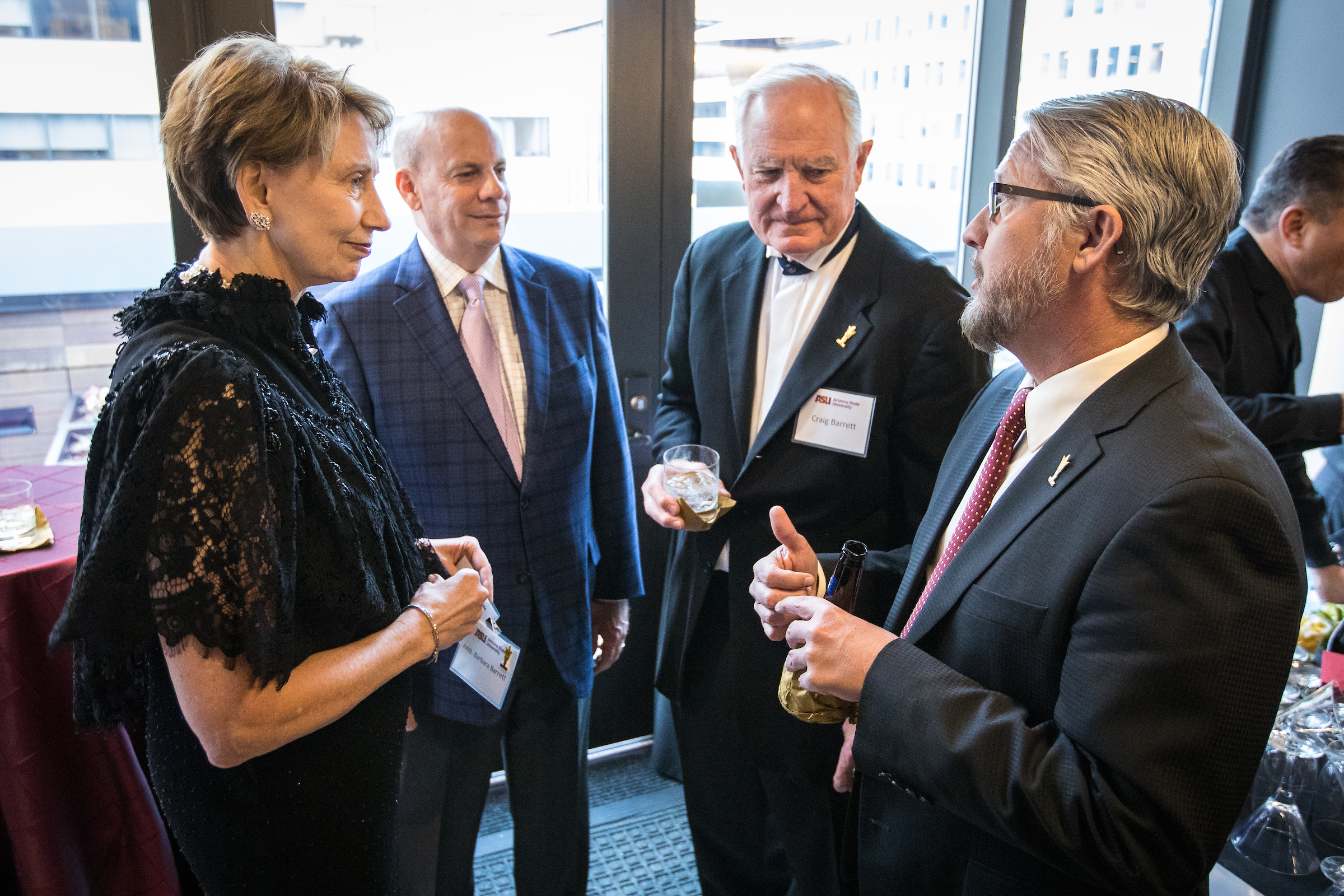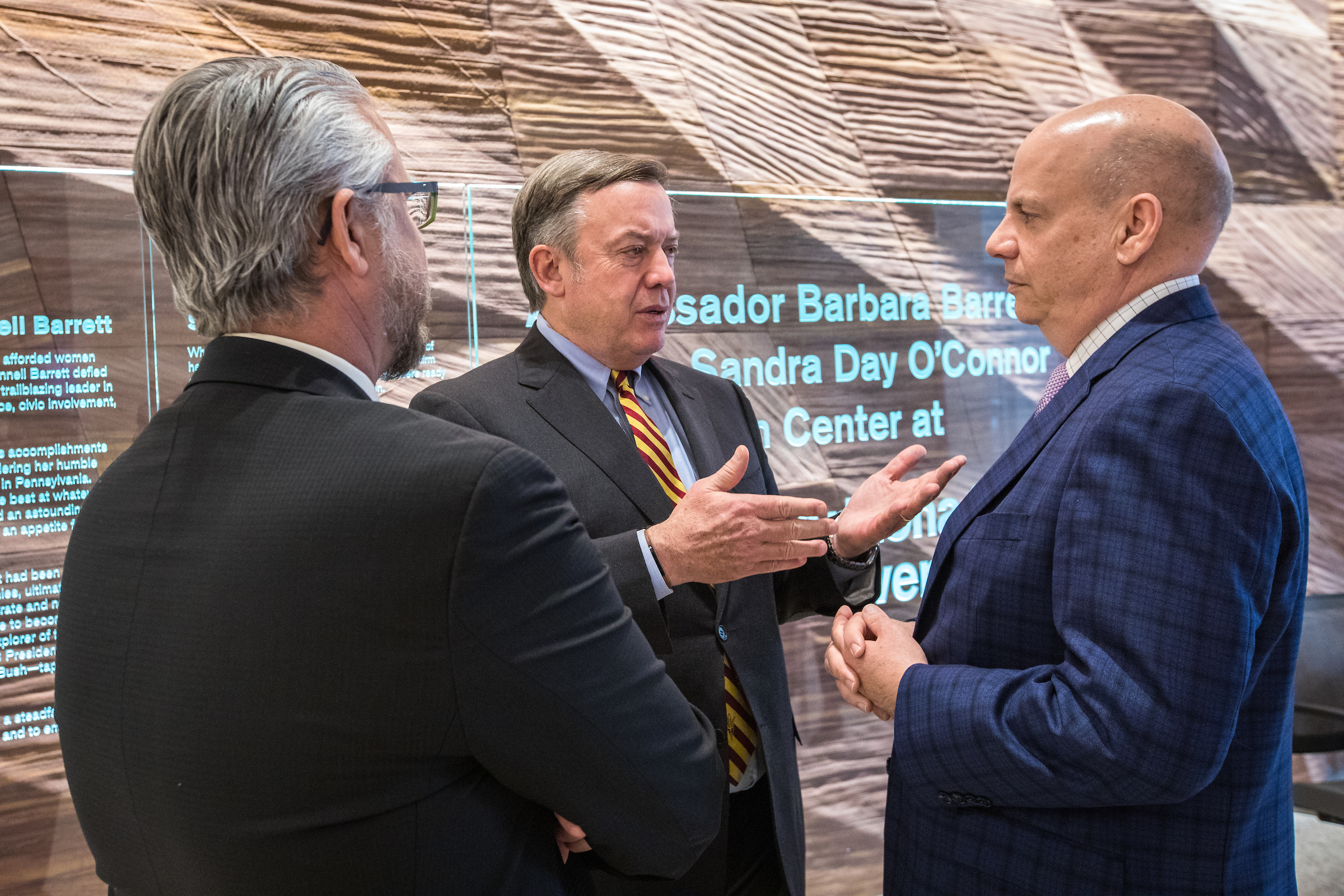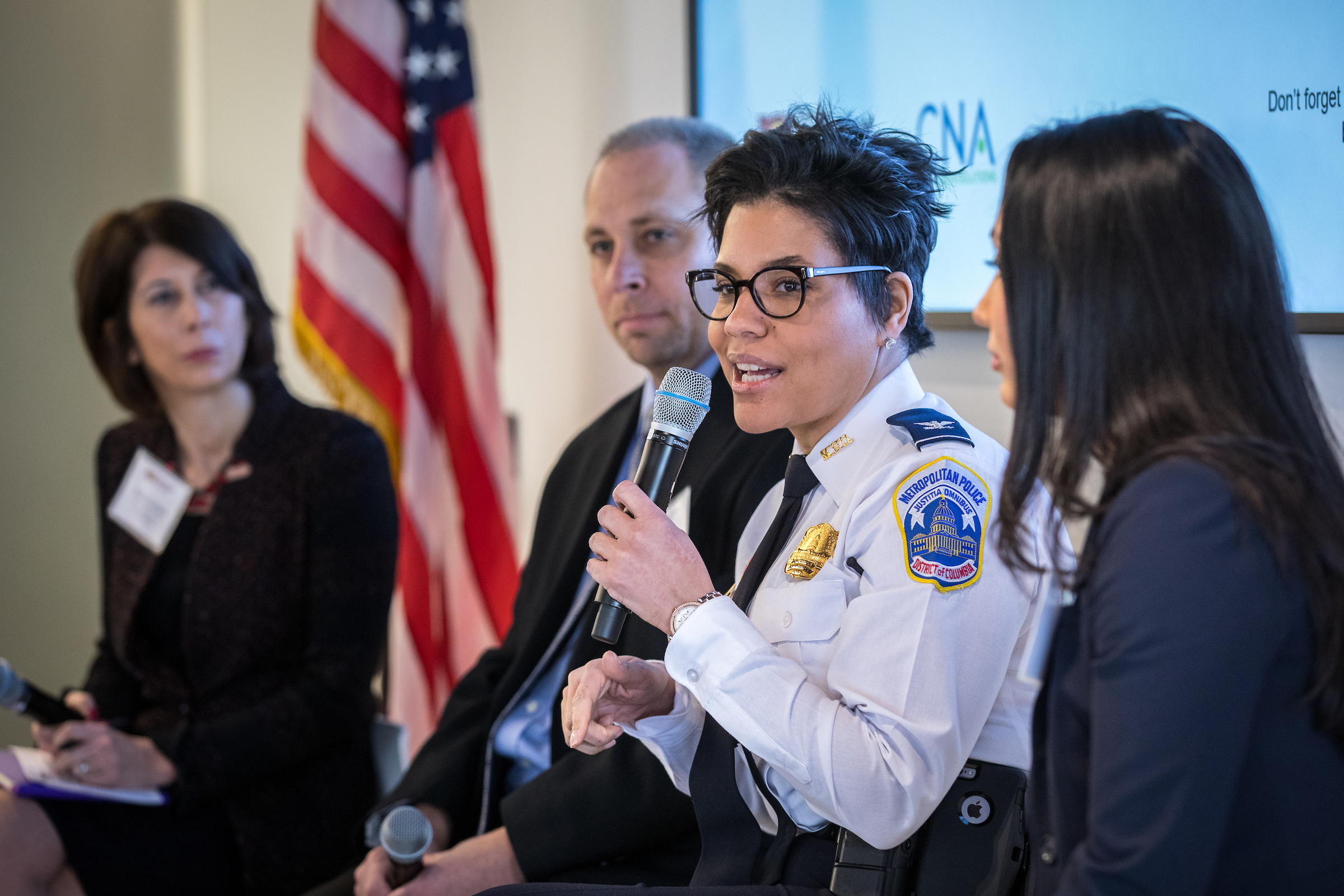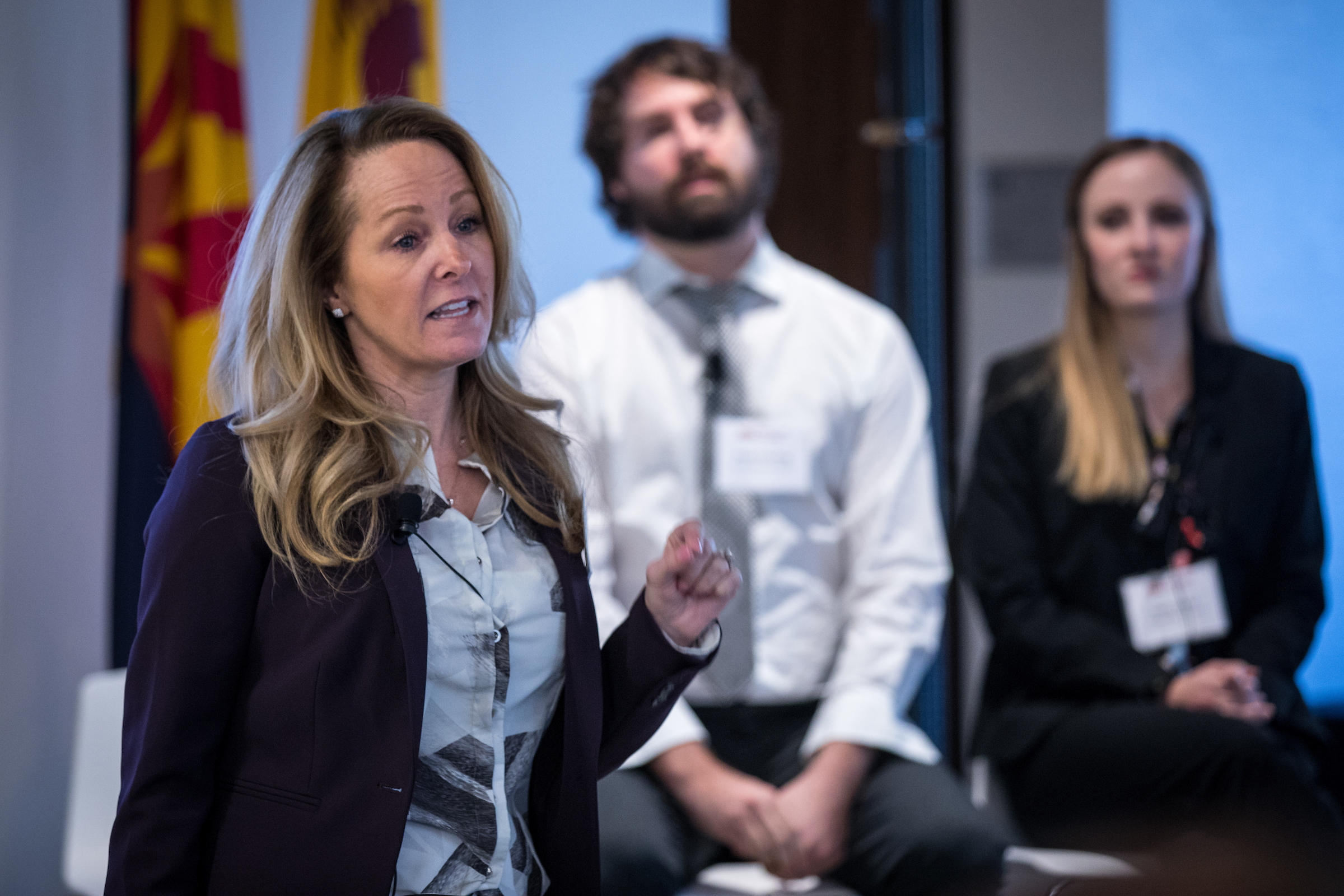Day 3: Grad student research, police and trust, and terror and the rule of law

Editor's note: Opening week continued at the Ambassador Barbara Barrett & Justice Sandra Day O’Connor Washington Center at ASU. Find the current day's blog here, with links to the other day's highlights.
Panel: 'Expanded Opportunities through ASU’s International Rule of Law and Security Program'
8:45 p.m. Wednesday, March 14
(From left) Barbara Barrett, Jay O'Connor and Craig Barrett listen to ASU Law Dean Doug Sylvester at a reception Wednesday evening at the Washington, D.C., center that bears the name of O'Connor's mother and the former ambassador. Photo by Charlie Leight/ASU Now
The Sandra Day O’Connor College of Law has some 200 alumni in Washington, D.C., and many of them were on hand Wednesday evening for a lively reception atop the new building that shares part of its name with the law school.
Former U.S. Ambassador-at-Large for War Crimes Issues and Distinguished Professor of Practice Clint Williamson — who served as the evening’s moderator — began with a description of the International Rule of Law and Security program, jointly developed by ASU Law and the McCain Institute for International Leadership.
In the program, students earning their JD degrees at ASU Law spend a semester in Washington, D.C., taking classes and working in an externship in such places as the Department of State, the FDA or the offices of members of Congress. The program also works to promote “rule of law”The meaning of the rule of law can differ by context, but in general it refers to the transparent and uniform application of laws to all citizens by an independent justice system not subject to the whim of those in power (which might be characterized as the rule of man). programs in places such as Mexico, Albania and Pakistan.
Williamson launched the evening’s panel by asking Nicholas Rasmussen about the mood at the White House immediately after 9/11.
The former director of the National Counterterrorism Center said, it was hard to remember just how “palpable that sense of fear was” that we were destined to face another attack. Government offices ran evacuation drills, and everyone was on edge waiting for the next attack.
“Rule of law was not at the front of everybody’s mind,” he said.
But eventually, it became clear that they would need a rule of law framework.
“As powerful as the United States was, it was never going to be in our power alone to conduct a global terrorism campaign,” he said — we had to work “by, with and through” global partners.
And through the changes in administration — from Bush to Obama to Trump — how has he seen the approach to rule of law evolve?
“I would argue there’s more continuity than change,” he said.
Nicholas Rasmussen (right) talks about the "rule of law" in the early days after the 9/11 terrorist attacks, during a Sandra Day O'Connor College of Law panel Wednesday night in Washington, D.C. ASU Law's Clint Williamson (left) served as moderator for the panel, which included Michael Sulmeyer and Stephanie Pell. Photo by Charlie Leight/ASU Now
Stephanie Pell, assistant professor and cyber ethics fellow at West Point’s Army Cyber Institute, was a prosecutor in Miami in the days after 9/11 and worked to write some of the first search warrants to search the residences of terror suspects there. She agreed with Rasmussen that the mood then was very much one of fear and feeling like the next attack was imminent.
“One thing we weren’t doing was searching smartphones. Why? Because they didn’t exist — not on September 11th. In the years since then, we’ve seen the advent of the kinds of technology … that most of us couldn’t get through the day without consulting,” Pell — who also holds joint appointments to the Department of English and Philosophy and the Department of Law — said Wednesday at the ASU Law panel.
She spoke about the case of Apple vs. the FBI as an example of new technology challenging our rule of law framework. The FBI wanting Apple to write new code to allow back doors for security; Apple said no. The government was used to getting access to data if it followed the appropriate steps, but this was a case of “competing visions of security,” Pell said: law enforcement wanting to thwart terrorist attacks, and providers of email and other services wanting to make sure they offered the most secure technology for their customers.
“If they build in access points that allow government access … those access points allow our adversaries to get into our phones as well,” Pell said.
Though the technology is changing, the cyber war is nothing new, said Michael Sulmeyer, director of the Belfer Center's Cyber Security Project at the Harvard Kennedy School.
He pointed out that “We are in the middle of a cyber war” was uttered almost 20 years ago this month by John Hamre, then deputy secretary of defense (speaking about the Moonlight Maze operation).
“So when someone tells you, ‘What are we going to do about this new cyber challenge,’ you should remind them 20 years we’ve been watching it. … This is not a new challenge,” Sulmeyer said.
He said that although we point to Russia as a cyber enemy much of the time, “they don’t win the prize.” He pointed to examples of Chinese intellectual-property theft, Iranian aggression and North Korean moves.
The problem, Sulmeyer said, is that hacking still pays — there’s more to gain by hacking than not, because the risks aren’t high enough.
“Hacking pays for Russia. All the arguments that say, ‘Russia, stop it,’ wag the finger, we’re going to sanction eight of your guys who don’t want to come to the United States anyway. …
“At some point, the best way to make sure someone can’t play baseball anymore is to take away their baseball bat. In the United States, we’ve been reluctant to take away their baseball bat … or hack them hard.”
Learn more about the Sandra Day O’Connor College of Law’s history in the nation’s capital at ASULawInDC.com. Watch Williamson talks about the Rule of Law and Security program, which recently changed its name from Rule of Law and Governance, in a video here. Find program FAQs here.
Photo: An O'Connor in the house
6:20 p.m. Wednesday, March 14
Jay O'Connor (right), son of Justice Sandra Day O'Connor, visits with Law School Dean Doug Sylvester and President Michael Crow on Wednesday evening in the lobby of the building named in his mother's honor. O'Connor later attended the ASU Law reception and "Expanded Opportunities Through ASU’s International Rule of Law and Security Program" presentation. Photo by Charlie Leight/ASU Now
Video: In search of the 'Star Trek' replicator
5:35 p.m. Wednesday, March 14
Owen Hildreth, assistant professor at ASU's School for Engineering of Matter, Transport and Energy, talks about his research that aims to improve the process for 3-D metal manufacturing — and get us one step closer to that replicator.
Video by Jamie Ell/ASU Now
Panel: 'Restoring Trust in American Policing'
5 p.m. Wednesday, March 14
A moderator and 13 panelists — including both researchers and active and retired police officers — covered a wide range of topics and engaged with members of the full audience at the panel “Restoring Trust in American Policing” on Wednesday at the Barrett & O’Connor Washington Center.
In this event sponsored by ASU's College of Public Service and Community Solutions in partnership with CNA, topics ranged from the use of force and its effect on community attitudes, to what kinds of data are collected by researchers and cities, to the crucial need for transparency and justice both inside and outside the walls of police departments. Here are highlights; watch the entire event on Facebook video here.
Cmdr. Morgan Kane of the Metropolitan Police Department in Washington, D.C., speaks on a panel on the use of force and its impact on communities as part of the "Restoring Trust in American Policing" event Wednesday. Photo by Charlie Leight/ASU Now
On the reality of the use of force:
“Force is not pretty. If you’ve been in the District of Columbia, you know we’ve had our fair share.”
— Cmdr. Morgan Kane, a 20-year member of the Metropolitan Police Department in Washington, D.C.
On “best practices” after conducting a study of how 662 police departments are instructing officers on how to use force:
“We didn’t find a silver bullet, we didn’t find a panacea — we didn’t find a perfect policy.”
— Bill Terrill, professor in the School of Criminology and Criminal Justice at ASU
On recruitment and expectations:
“We think of law enforcement and then we use the term ‘policing’ They’re not subtle differences to me. Law enforcement is a small part of the job; policing is most of the job. We know going back to the 1960s that much of what police do is not enforcing the law; they’re dealing with people’s problems, right? … Most of their time is spent on social work. So from a recruitment perspective, I hammer this into my students all the time. If you just want to chase the bad guy, you’re probably going into the wrong occupation.”
— Terrill
On the need for community relationships:
“We’re not welcome everywhere. But what continues to surprise me, amazes me and warms my heart is when you go into some of these communities and when you take the time to explain what you’re doing and be transparent in what it is that you’re doing and why you’re doing it and to have discussions — open and honest discussions, the reception changes and now you have a community partner. … That relationship is so important. We can’t be successful without our community giving us information and telling us when something doesn’t look right — the hairs on the back of your neck, ‘This just doesn’t look right’ — if we don’t have that relationship, we can’t prevent crime and keep people safe.”
— Kane
On what the data says on whether body-worn cameras reduce the use of force:
“Every department is different. So again, what works for one department might not work for another. And you also have to factor in there are some departments that don’t have issues with public trust. So they might not have high numbers of use of force or high numbers of complaints, so they’re not going to see reductions in complaints."
— Denise Rodriguez, research scientist with nonprofit research and analysis organization CNA
“One of the things I’ve been doing with a colleague … is trying to get an assessment of how many studies have been published and what do they say. So we’ve documented now 14 different studies that have been published that look at use of force. Seven of the 14 document a significant decline in use of force. So half do, half don’t.”
— Michael White, professor in the School of Criminology and Criminal Justice at ASU
On the importance of data sharing:
“Collecting data could not be more important today than any other time in our history. When I go back to 1990, when I started with (a previous police) department, I remember we were so bad at sharing information within our own organization that we couldn’t even imagine sharing it with the community. I remember being on an undercover sting operation for a couple of weeks because we were trying to catch a burglar — only to find out that the detectives had caught that guy two weeks earlier but had forgotten to tell patrol. … Fast-forward some 25 years forward and I’m just really proud of the tremendous work being done across the country … on getting data out there to the community.”
— Eddie Reyes, new director of the Office of Public Safety Communications in Prince William County, Va.
On data vs. perception:
“If there’s one thing I’ve learned about public life, it’s that stories beat the hell out of data every day of the week. If you have a critical incident in your community and all hell breaks loose, it doesn’t matter — for example, in Milwaukee we can demonstrate a 77 percent reduction in complaints against the police over a 10-year period, we can demonstrate a 40 percent reduction in reported uses of force even after we had expanded reportable uses of force. Many police departments can show all kinds of trend analysis that show improvements in activity, that show improvements in the results of their work and improvements at the neighborhood level, in terms of citizen perception. But when you have a critical incident, particularly when it’s captured on a body-worn camera or somebody’s cellphone, that defines policing for news media coverage, political engagement and the mobilization of activist communities. That becomes the reality. So data does have its limitations, particularly in terms of a crisis.”
— Ed Flynn, retired Milwaukee police chief
On procedural justiceProcedural justice is the idea of fairness in the processes that resolve disputes and allocate resources — including issues of promotion. inside and outside the police department:
“I find it very difficult to place those expectations on police officers when they, as you suggest, they don’t get that treatment hardly at all.”
— James “Chip” Coldren, managing director of the Justice Group at nonprofit CNA
On body-camera footage and the courtroom:
“One thing we fail to appreciate as we think about body cameras — the beginning of the conversation is very focused on use of force, complaints, etc. But there is this evidentiary value piece that we’re still trying to track through the process of how does it affect our internal investigations on the criminal side as well as internal to the police force, and we do see some anecdotal evidence of it speeding up those investigations. If you get a frivolous complaint, you can very quickly identify it as such and put the officer back on the street. … We’re also seeing, though, on the prosecutorial side — it’s a lot of video footage, right? If you have like 15 officers on a scene for three hours, you can only imagine how much video footage they’ve got to comb through to extract that evidentiary value. … How are we presenting this video footage in court. Is it necessarily the officer’s perspective? … What are the jury instructions around things like that? On the evidentiary side, there’s so much more to explore in terms of how the footage is playing out in the downstream criminal justice processes.”
— Anita Ravishankar, research fellow at the Lab @ DC and a member of the Metropolitan Police Department team
Video: Studying grasshoppers and helping farmers around the world
1:25 p.m. Wednesday, March 14
Ariel Rivers, program manager for the Global Locust Initiative, talks about why we should care about grasshoppers and locusts — and their role in global food security.
Video by Jamie Ell/ASU Now
Panel: 'Transformative Knowledge by Design: Graduate Student and Postdoctoral Fellows’ Research Impact'
11:30 a.m. Wednesday, March 14
Alfredo Artiles, dean of the Graduate College, led a discussion with Karen Gallagher, PhD alumni; Peter Marting, PhD candidate in animal behavior; and Emily Zarka, PhD candidate in British romantic literature, about the importance of communicating scientific discovery and research in a way that is accessible, impactful and engaging for the public.
According to Artiles, “We are living in an era of unprecedented knowledge production. There has never been a time that we have gathered so much information that is useful, but not used.” This, he explained, is the challenge facing scientists and researchers that must be overcome, merging scientific endeavor with social needs.
Knowledge mobilization is concerned with access, use and impact. To demonstrate the possibilities of knowledge mobilization, Artiles welcomed the three panelists to share their stories in a TED Talk-style presentation.
Clinical Associate Professor Karen Gallagher talks about her work with military veterans and their cognitive issues at the ASU Graduate College's panel discussion on Wednesday, March 13. Gallagher, a Tillman scholar, was joined on the panel by doctoral candidates Peter Marting and Emily Zarka. Photo by Charlie Leight/ASU Now
Karen Gallagher, clinical associate professor, College of Health Solutions
An Army veteran herself, Gallagher was inspired to address the lack of resources and support available to veterans transitioning out of the service. Thirty-three percent of military transitioning out will have some kind of brain injury. Forty-four percent will have post-traumatic stress. “We are failing a large number of our military veterans,” she said.
She explained that in the service, “We know what our mission is, who our team is and what success looks like. But no one tells you how to be successful post-service.”
To address the problem, Gallagher created the Veteran Cognition and Academic Success project.
She developed tests that were sensitive to non-traumatic brain injury; that looked at the whole person to understand what was going on, not just the clinical diagnosis. She taught veterans how to define their own missions, identify their own teams and connect with resources that could help. And it worked.
To increase the impact of her work, she presented at international conferences, wrote news articles, gave interviews, published her findings in academic journals and spoke with politicians. “I wanted everyone to have access to the knowledge I found.”
Peter Marting, PhD candidate in animal behavior, School of Life Sciences
Marting studies tree ants and how they differ in their response to various stimuli. Recognizing that his research subject was fairly opaque, inaccessible and difficult for the general public to understand, Marting sought a way to translate his research into something impactful. He chose art.
“Scientists ourselves, at this level, are very creative people,” he said. His challenge was to find a way to take the subject he was passionate about — ants — and create something visual that expressed emotion and communicated his research findings to the public.
By working across disciplines, with professional artists and designers, he created an inspired and imaginative art display that uses light to show the reaction of ants to stimuli in their environment. The project is as beautiful and diverse as the research behind it.
Through the fusion of science and art, Marting hopes to encourage others down a path of “artistic expression of original research,” with the goal of “making science communication beautiful.”
Emily Zarka, PhD candidate in British romantic literature, Department of English
“I’m Emily Zarka, and I’m a monsters expert.” No stranger to skepticism, Zarka must find creative ways to express how her research of zombies, vampires, mummies, walking corpses and other things that go bump in the night, has public value.
“I’m particularly fascinated by the undead. When the living come in contact with such a creature, we are forced to acknowledge our own existences and identify our own monstrous qualities.”
“I’m always looking for new ways to teach history through monsters. Human history is, in fact, monster history.”
To share her research and passion for monsters with others, she authored a chapter in an upcoming book about race, gender and sexuality in "The Walking Dead" comic series; presented at national and international conferences; had an article published in a national publication; and regularly engages with other academics at ASU in an interdisciplinary fashion.
Her ultimate goal? “One day I’d like to have my own television show where I travel the globe visiting different countries and communities and exploring the unique monsters and their individual histories.” This would allow her to expose her findings to a larger audience and to explain the complex historical and social motivations that have caused every culture since the beginning of time to create monstrous bodies.
“My work shows there is an approachable way to engage everyone from children to academics in thoughtful conversations about larger social issues. The monster is a way to talk about poverty, racism, sexism, discrimination and the social condition in a way that is exciting and approachable. To understand monstrosity is to understand humanity.”
“So I ask, ‘What are you afraid of?’”
READ MORE: Army vet studies brain injuries in soldiers
READ MORE: Snobs and slobs: Ants are just like us
Video: Hacking the hackers
11:12 a.m. Wednesday, March 14
Fulton Schools Assistant Professor Paulo Shakarian talks about the importance of using advanced machine learning to monitor the dark web for signals of impending cyberattacks. He also touches on ASU's emphasis on use-inspired research, which led to cyber watchdog spinoff Cyr3con.
Video by Jamie Ell/ASU Now
A brief history of the building at 1800 I St. NW
10:59 a.m. Wednesday, March 14

1800 I St. NW today. Photo by Charlie Leight/ASU Now
Owner, architect, and builder Joseph J. Moebs began construction of the 1800 I St. NW building in 1915. Moebs, born in Boston around 1875 to German immigrant parents, is credited for the design of this and 103 other buildings in Washington, D.C. — mostly dwellings — between 1905 and 1931.
The 1800 I St. NW building originally consisted of 25 apartments and three offices; it was built at an estimated cost of $60,000.
Upon completion, Moebs sold the building to John F. Conaway, who most likely commissioned the building. Over the years, inhabitants from all walks of life occupied this building; in the 1930s rent ranged between $20 and $90 per month. In 1926, Charles Pettinato opened the “Charles Barber Shop” on the ground floor, which his son, Nunzio, ran until 1965.
Conaway and his partners eventually sold the building to the Granite Street Corporation in 1946, which continued to manage the building as apartments; in 1960 it was converted to an office building and named the Medical Building, hosting medical and dental offices over the next few decades. The building had several other owners before University Realty purchased it in December 2014.
Video: Solar fishing lights, diabetes prevention
9:25 a.m. Wednesday, March 14
During the morning's presentation "Transformative Knowledge by Design," the Graduate College showed this video showing how ASU students' research and passion are making a difference in the community.
Learn more:
- Solar fishing lights: One biologist’s bright idea, inspired by a lifetime love of the sea
- ASU diabetes prevention research sees promising results
FB Live: ‘Restoring Trust in American Policing’
7:40 a.m. Wednesday, March 14
The panel “Restoring Trust in American Policing” will be livestreamed on ASU's Facebook page at 11:30 a.m. Eastern Daylight Time today.
Katherine Reedy and Penny Walker contributed to this blog. Top photo: Jay O'Connor, son of Justice Sandra Day O'Connor, visits with Law School Dean Doug Sylvester in the lobby of the new Barrett & O'Connor Washington Center on Wednesday in Washington, D.C. Photo by Charlie Leight/ASU Now
More Law, journalism and politics
Can elections results be counted quickly yet reliably?
Election results that are released as quickly as the public demands but are reliable enough to earn wide acceptance may not always be possible.At least that's what a bipartisan panel of elections…
Spring break trip to Hawaiʻi provides insight into Indigenous law
A group of Arizona State University law students spent a week in Hawaiʻi for spring break. And while they did take in some of the sites, sounds and tastes of the tropical destination, the trip…

LA journalists and officials gather to connect and salute fire coverage
Recognition of Los Angeles-area media coverage of the region’s January wildfires was the primary message as hundreds gathered at ASU California Center Broadway for an annual convening of journalists…






